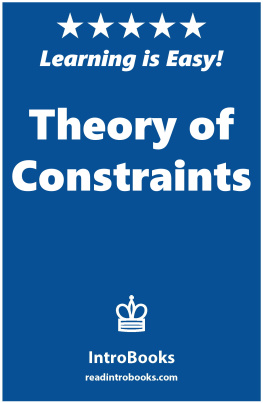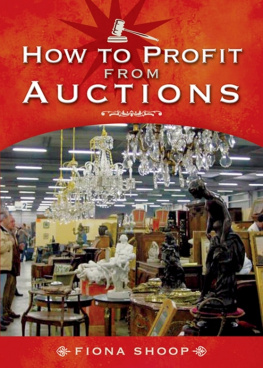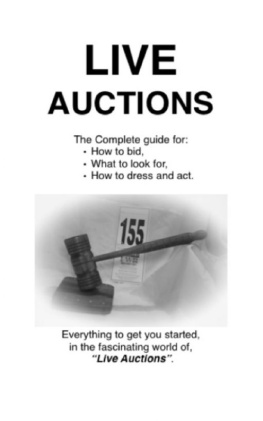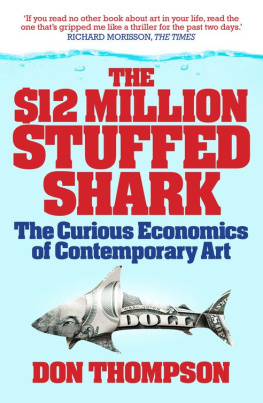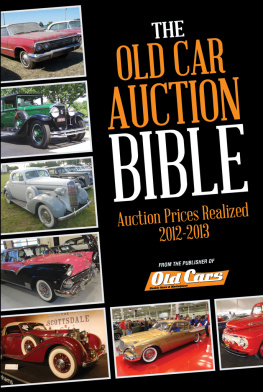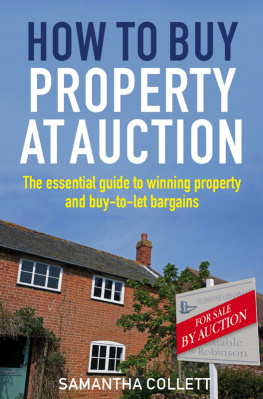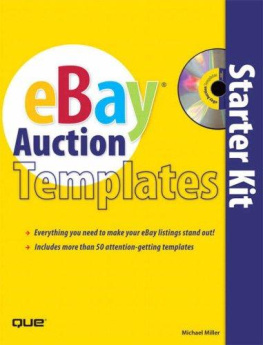Table of Contents
Auction Theory
IntroBooks #229
readintrobooks.com
Copyright 2016 Can Akdeniz
All rights reserved.
Preface
This theory finds its origins in field of economics. It is said to be an applied branch of the very same field. In this theory, many ways in which people act in auctions are included. This theory also describes properties possessed by auction markets. An auction may follow a certain rule or set of multiple rules. Such sets of rules are known as auction designs. These designs are also a part of this particular theory. Auction theory is said to be a representation of a standard and utilized design for real life auctions. This theory particularly targets auction designs for public sector companies and the use of sale of license.
Some main parts of this broad theory about auctions may also include the following:
Every individual that is familiar with economics or is building up his career in the field of economy or corporate is most likely to be very much familiar with the term auction. Auction is indeed a simpler term to understand. Main goal of auction is to put an effort to sell selective stuff at a most convincing and affordable rate according to sellers prospective. This statement can be said most simple definition for auction. According to a more descriptive and professional definition, Auction is a public or private sale (In many cases) in which the sellers makes a deal with the bidder that offers highest amount for the respective stuff. Some experts also consider that auction can be called a system for selling since it is holds a well-structured format. According to this theory or concept, the definition for auction is, It is a system, in which competitive bids from potential buyers are placed on stuffs that is put for sale. The selling item can be a property or even goods. The goods are handed over to the highest bidder in exchange of the price that he previously offered for the very same item. Both seller and buyer [in most cases it is seller only] have to pay a small fee to the auctioneer for listing the item. Usually, sellers pays the fees for listing the item in particular auction and buyer pays entry fees o get the right to bid from the auctioneer. Once the deal has been finalized or bids have put on the item, seller have no right to refuse to pay the fees in any terms, not even if the item is not sold at a desired price or revenue. Most of the modern auctioneers make a legal contract with both sellers and bidders so they are not caught in such situation where buyer and sellers make a deal and refuse to pay fees for their services or intermediation, whatever it is called.
All the concepts that are related to auction in any way are included in Auction theory. Like any other theories, it explains all terms related to the field while making sure that the description is much likely related to the main subject.
Introduction
As according to various general definitions of auctions, it can be said that auction is a process in which any particular property is sold to a potential buyer who offers highest price for that particular good. The outcome or result of auctions depends on the bids only, which means that bidders identity does not matters at all. There are said to be multiple forms or say types of auction. Almost each form of it satisfies following conditions:
Type of item does not matter. Auctions can be used to sell any kind of stuff from antique items to real estate they do it all! Due to this, they are said to be universal.
Anonymity is maintained until the deal has been finalized. As bidders ID should not affect on the auction, it is always better to keep it private until the deal has been finalized. Open auctions are exceptional for this rule.
Most of auctions ask buyers to pre-submit their bid along with the amount they want to offer for a particular item. In case of standard auctions, it is made sure that the winner is always the person who has offered the highest amount, in simple words who is the highest bidder. In nonstandard auctions this rule can be simply ignored, that is why they are called nonstandard! Lottery is a great example for this. Some theorists do not consider lottery as an auction since nothing is put for sale and as it ignores a fundamental rule provided in auction theory. As said before, auction can be highly modified, thus there are many new categories implemented for auctions. Theory of auction is all about four fundamental or standard types of auctions. These standard types are listed below:
First-price sealed-bid auctions
Second-price sealed-bid auctions or Vickrey auctions
Open ascending-bid auctions or English auctions
Open descending-bid auctions or Dutch auctions
Every concept or idea described in Auction theory can be completely applied to any of these four auction categories. One can find many topics in theory of auction, which cannot be applied to many of the modern categories. It is much likely to happen since when the theory was in its development phase; such categories did not even exist. They are still not been included in the theory of auction since they fail to maintain the pure or standard form and structure for auction and due to that they have many limitations, these auctions cannot be affective in every field. Despite of being developed from any of the four fundamental auction types they cannot progress their development to an error-free stage. There are many other reasons that cause the scope of auction theory to be limited to these four types of auctions only.
Most concepts of auction theory moving around these four standard types, yet there are many other auction types that received academic attention. Some researchers even argue that they should get a place in modern auction theory. However, they are described in modern resources only.
Chapter I
Primary/Standard Types of Auction
In order to provide allocation for a single item, auctions are divided in following four traditional types:
First-price sealed-bid auctions:
These auctions are also known as blind auctions or sealed first-price auctions. The bids are kept secret until the result is declared. In this way, no bidder knows what amount the other person is going to bid. Bids are often delivered to auctioneer in a sealed or closed envelop. The bidder that offers highest bid has to pay the price he offered and receives the deal for the very same item. A major difference between blind auctions and English auctions is that bidders are not allowed to submit more than one bid. This rule prevents bidders from lowering the price than the price the item deserves. Each bidder tries to predict accurate price for the item, which is in much favor of the seller and the auctioneer too. Blind auctions also prevent bidders from incrementing or decrementing their bid according to other bids since they cannot see any and have only one chance to bid. Many theorists and researchers argue that this concept is very much similar to concept of Dutch auctions in a strategic perspective. However, many studies and observations have successfully proven that due to their high clock speed, Dutch auctions are said to yield lower prices compared to Blind auctions. Blind auction are preferred for government contracts and mining leases.
Second-price sealed-bid auctions:
These auctions are also known as Vickrey auctions. This type of auction is very similar to blind auctions or first-price sealed bid auctions. The only difference is that the winner pays the amount that is offered in second highest bid. Here, it should be noticed that bidder with highest bid is declared winner not the not the one with second highest bid. The winner pays the price of second highest bid rather than the price of his own bid. These auctions hold a special importance in auction theory. The concept of Vickrey auction is usually used with automated contexts; real-time bidding for online advertising could be a great example of automated context. Second-price sealed-bid auctions are not much likely to be used in non-automated fields, use of them in such fields tend to be very rare.


